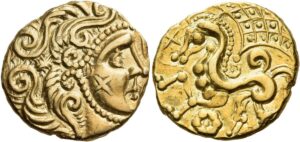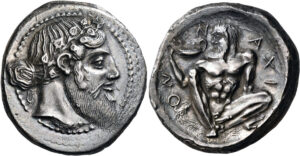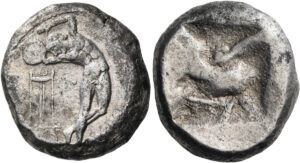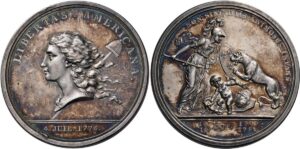Remarkable Ancient Coins in Nomos 21
by Alan Walker
Nomos 21 is Nomos’ second sale during the Covid era, and like Nomos 20, it contains all sorts of interesting and exciting coins, which will help take everyone’s minds off the spread of viruses, turning them towards rare, historic and beautiful relics of the past. The coins in this auction have survived centuries of upheaval, war, invasion, plague and famine, and all bear optimistic testimony to survival and betterment. Another thing that these coins will do is provide the viewer – the collector, the dealer, the scholar – with a great deal of enjoyment and, yes, education: after all, whenever we see a coin and read its description we have the chance to increase our own knowledge of both numismatics and the past. Quite a long time ago I did some research in the Coin Room of the British Museum, which was located behind a door in what was then termed the Greek and Roman Life Room. To get there I walked through two long rooms; as I remember one was filled with large numbers of statuettes and other small objects in bronze and the other with a plethora of Greek pots: if you looked at each piece carefully you could waste a whole day doing so – and not only that, you would soon suffer a sensory overload. So what I would do was speed through the rooms until my eye was caught by a single object, at which I would stop, examine it carefully, and then rush on to the coins. In other words, I saw a everything, but I really only looked at a few! Does that make sense? In any case, it is exactly the same with coins, you can flip through a catalogue, looking at coin after coin until you suddenly see one, which truly catches your eye.

Well, in Nomos 21 there will be a lot of coins that will catch your eye. The coins in the sale come from a variety sources, primarily private collections, both relatively recent ones and some going back as much as a generation or so (as the Aletheia, Belser, and Duke Collections). There are also coins with pedigrees going back to well-known collectors of the earlier 20th and late 19th centuries. For example, lot 99, a silver stater from Abdera, comes from the Aletheia Collection, but was previously in a Belgian and a Portuguese collection, in the Garrett Collection, and from the collection of C. S. Bement and that of R. Allatini, who sold it in 1904, but bought it in the 1890s.
But now let’s look at some highlights of the sale: today they include some coins of great rarity, great beauty and, sometimes, of great value; but I have also added two pieces with very interesting pedigrees, both of which have been supplemented after the catalogue was written by our new associatecin Australia, Dr. John Voukelatos. Many people know of him as a distinguished heart surgeon in Melbourne, but he is also a passionate Hellene with a great love for the past, especially for Greek coins. He is starting a project to find the pedigrees – provenances and proveniences – of coins that interest him; and he has already had some startling results. I am going to present two of them here, and both are really big surprises!
Lot 1 is an impressive and most attractive gold stater of the Gaulish tribe, the Parisii, whose coins are rightly famous for their flamboyantly exuberant style. On the obverse is what is normally termed a celticized head of Apollo, with wildly curled and flowing hair, two lines of pearls outlining his face, and a tattoo on his cheek. But could this actually be derived from the head of Alexander on staters of Lysimachos? There are a number of intriguing parallels: do compare them if you can. On the reverse we have a prancing horse with a large, fan-like ornament above. An unusually nice example; it is estimated at 32,500 CHF. Back in 2011 this coin was the first lot of NAC 59: it was a highlight of the sale then and it still is now.
The first of Dr. John’s surprises, a drachm of Zankle (Messana) struck c. 520-500 BC (lot 75, est. 4,500 CHF). It comes from the Duke collection, purchased from the well-known American numismatic profession, E. J. Waddell in 1984. We knew before that it had been in a Spink sale in 1977: but now we know that it was also once in the collections of John Ward and the Metropolitan Museum of Art in New York City (Sotheby’s Zurich 4 April 1973, 159 and Ward’s Greek Coins and Their Parent Cities, pl. IV, 205), and was actually found in Messina in 1895 (IGCH 2062). This information is not in the printed version of the catalog!

Here we have lot 80 (est. 450,000 CHF), not only a great highlight of this sale, but of any sale, and one of the greatest and most desirable of all surviving coins of the 5th century BC: it is a specimen of the famous early Classical tetradrachm of Naxos, Cahn 54. When H. A. Cahn’s wrote his die study of the coinage of Naxos during the 1930s, he and his brother Erich had wisely moved to Switzerland in the face of the increasing nazi terror. The fact that he researched and studied, helped run his new family firm, Münzhandlung Basel, and corresponded with and managed to visit scholars, collectors and museums all over Europe in such uncertain times is a testimony to his energy and confidence. He finished the manuscript in 1940 (he was then only 25) and was able to have it published in 1944 by Birkhäuser, a Swiss firm specialising in academic and scientific literature. Cahn was safe in Switzerland while around him Europe was in flames: so many of the cities and towns he knew so well were being bombed to pieces, and so many friends, relatives and colleagues had been made refugees or murdered. Working on coins must have kept him sane. Cahn recorded this coin as then belonging to the Belgian businessman Edmond Dresse de Lesbioles (1870-1940, but actually Lébioles), who lived in Liege and died shortly after the German conquest of Belgium in May 1940. He must have been a serious collector – he is recorded as a mail bidder in a number of Ars Classica auctions in the 1930s – and it would be useful to know when his collection was dispersed – and what else was in it.
The great beauty and importance of this coin has long made it one of the most sought after of all Greek coins. It would be most interesting to know when an example first entered a collection, and when one was first published. Cahn did not attempt to research the collecting history of the coinage of Naxos, but we can be sure that pieces were certainly in collections by the 17th century at the latest (the BM piece is ex Cracherode, who acquired it between 1773 and 1799; the de Luÿnes piece in Paris was acquired prior to 1862; and the piece once in Gotha should go back even earlier). The power of the head of Dionysos on the obverse and the figure of Silenos on the reverse must have struck every observer and it would be intriguing to know if any artists or writers were influenced by them.
The second coin found by John V. is lot 92, a 4 litra piece of Tauromenion, minted in 304-289 BC (est. 1,500 CHF). It is a really nice coin, well-struck, toned and attractive; when I catalogued it, I found a pedigree going back to Gorny 50 in 1990. But that is not all: Going back further, it was lot 85 of the Rudolfo Ratto sale of 9 October 1934, lot 170 of the Headlam Collection, Sotheby, Wilkinson & Hodge 8 May 1916, and, finally for now, from the Hazlitt Collection, Sotheby, Wilkinson & Hodge, 5 July 1909, lot 114.
Lot 178 (est. 12,500 CHF) is a very rare and attractive hekte from Kyzikos, struck in the later 5th century BC. What is really fascinating about it is its type: Kekrops, the mythical first king of Attica. He was half-man, half-serpent and had to judge between Athena and Poseidon, who were both vying for his kingdom’s allegiance: Athena offered the olive and Poseidon a salt-water spring on the Acropolis. In the end, Kekrops chose Athena so he is shown here holding an olive tree and wearing an olive wreath (which can be clearly seen in this enlarged photograph). This piece is probably the finest known example of the type. It is intriguing to note that the ancient Egyptians often represented their gods as having animal heads on human bodies; but the ancient Greeks very seldom did so, preferring to have human heads or foreparts on animal bodies. This shows that the two peoples had a wholly different conceptional view of the mythical world that surrounded them. And could you imagine Kekrops with a serpent’s head and a human body?
Then there is a drachm from Smyrna, minted in the late 3rd or early 2nd century BC (lot 196, est. 4,500 CHF), and it is extremely rare, very elegant and of the greatest interest. The obverse bears a slightly archaising Hellenistic head of Apollo of a type that was fairly widespread on the coinage of the period. The reverse, however, bears a heroically idealised seated figure of Homer, in a pose reminiscent of that of Zeus on the coinage of Alexander or, for example, the figure of Asklepios on the slightly earlier drachms of Epidauros (BCD 1236 and 1240). He is shown as a mature and muscular man, his hair apparently carefully bound with a taenia. He is bare to waist and wears a himation that is either draped around his legs or falls beside them – a fold does fall down from his shoulder – and a pair of sandals. He sits on what appears to be a solid marble throne, of the kind found in a theatre; and he holds a scroll in his right hand and a scepter with a curious, thyrsos-like head. The artist who engraved this reverse die was extremely talented, producing a noble and beautifully detailed figure. The fact that Homer holds a scroll is intriguing: he was traditionally thought to be blind, so if that were the case how could he be preparing to read from the scroll he carries? In fact, while many surviving ancient marble heads or busts of Homer clearly show him to be blind, others, apparently following another tradition, do not, so it would be interesting to speculate that he was thought to be sighted in Smyrna (cf. G.M.A. Richter, The Portraits of the Greeks, London 1965, pp. 45-52 for both blind and seeing heads; and for the relief in Berlin, Richter p, 54 m and fig. 119, that actually shows him reading from a scroll).

Lot 204 (est. 65,000 CHF), an extremely rare triple silos from Kos, was minted a decade or so earlier than the Naxos tetradrachm described above: it, too, is a remarkable representative of the art of its time. Struck c. 480-475 it shows us a nude athlete who is bending, twisting, and just about to hurl a discus he holds in his right hand. Behind him to the left is the tripod he is undoubtedly going to receive for his winning toss. The style of the figure makes it clear that the die was cut by an engraver who was a contemporary of the sculptor who made the so-called Kritios Boy, which was found on the Acropolis in Athens and dates to c. 480. Our artist was slightly more conservative in his style than his Athenian contemporary, but that is probably because he was working in Kos rather than in Athens, the most important center of artistic development at the time.
Now we are going to take a short trip from Kos to Rhodes, but a great jump in time: from the first quarter of the 5th century BC to the second quarter of the 2nd century AD! Lot 330 (est. 250 CHF), a seemingly insignificant bronze hemiassarion of Marcus Aurelius Caesar struck c. 139-144. It has an attractive reddish-brown patina (described as tan in the catalogue) and two vigorous portraits: a bare headed bust of Marcus on the obverse and a wreathed head of a youthful Dionysos on the reverse, both face to the right. They have the quality of bas-relief decorative roundels intended to be hung on a wall. There is also one very carefully thought-out, even refined element about their design: Marcus’s name, Verus, is written from left to right, starting on the left of his bust and finishing on the right, ΒΗΡ – ΟC, while the city name is written from right to left, starting on the right of Dionysos’s head and finishing on the left, ΡΟΔ – ΙΩΝ. This must have been done intentionally by the engraver as a way of balancing the two sides. By the way, the emperor Marcus Aurelius was named Marcus Annius Verus at birth, and after various vicissitudes was named Marcus Aelius Aurelius Verus Caesar upon his adoption by Antoninus Pius. When he became emperor he took the name Marcus Aurelius Antoninus Augustus. That explains why he is called Verus on this attractive little coin!
Lot 352 (est. 50,000 CHF) is a truly impressively elegant medallion of Carinus Caesar, which was struck in Rome during the year 282. It has the standard reverse showing the three Monetae: the ones in charge of aes and silver on the left and right, and the Moneta in charge of gold, with her distinctive hairstyle and long-handled scales, at the center. On the obverse, however, we have one of the noblest and best engraved portraits of Carinus ever to appear on any coin or medal. This is a three-quarter bust: he is wearing armour covered by a cloak, and a laurel wreath on his head. His hair, cut short, beard, moustache and eyebrows are perfectly groomed, and his expression is calm but stern. Neither Gnecchi nor Delbrueck (Die Münzbildnisse von Maximinus bid Carinus – Berlin 1940) have any real parallel, but the medallions of Carinus and Carus illustrated as Delbrueck pl. 29, 5-6, are almost certainly from the same issue (Bastien, Le Buste Monétaire…, has no parallel for it at all). This is a coin that gets more and more impressive as you look at it. While the term masterpiece is often misused when describing a work of art, it is perfectly correct for this piece.

Finally, we come to the last lot of the sale, lot 396 (est. 100,000 CHF) one of the two or three most important medals Nomos has ever handled, and certainly the most important of all American medals: the Libertas Americana medal of 1783. This medal was conceived of in 1782 by Benjamin Franklin, the American ambassador to France, its designs were refined by the then prominent painter and archaeologist E.-A. Gibelin from Aix, and the dies that struck it were cut by Augustin Dupré, the engraver and medalist. The first medals were produced and sent out in mid-April 1783: there were a small number of silver pieces, like this one, which were struck for prominent recipients (like the President of Congress in the US and the ministers of the French Court), as well as a larger number in copper (only 23-25 silver pieces exist today). The complete description of this piece, and especially the complex symbolism of the reverse, can be found in the catalogue entry and its notes, but it seems more than just worthwhile pointing it out here. After all, this just has to be the important and evocative of all American medals.
All lots of Nomos 21 can be found on the Nomos website.




